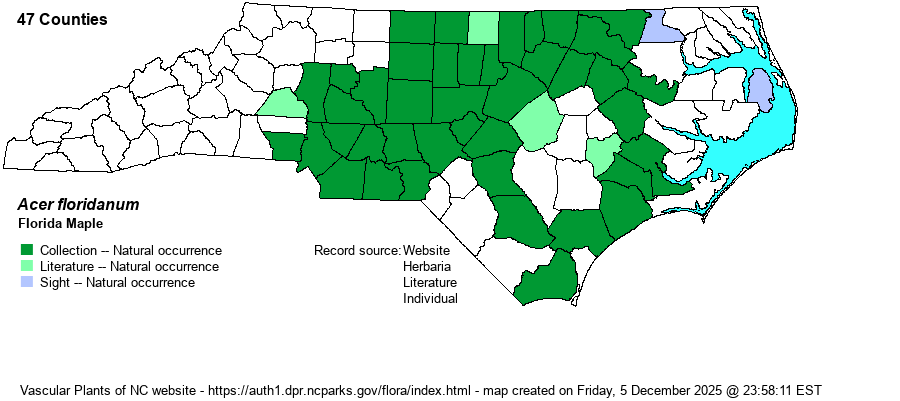| Author | (Chapman) Pax | |
| Distribution | Throughout the eastern 65-70% of the Piedmont, west to Rockingham, Iredell, and Gaston counties, but absent in the western portions; absent in the Mountains. Present over much of the western and central Coastal Plain, being absent mainly from the Tidewater areas north and south of Albemarle and Pamlico sounds. No records for a group of counties in the central Coastal Plain; is this a real gap in the range? The many iNaturalist photos from farther west than show on the website map of specimen data are not included on the map, owing to possible roadside plantings or misidentification.
A Southern species ranging north only to central VA and MO; occurs south to central FL and eastern TX. Essentially absent from the Appalachians and the Cumberlands.
| |
| Abundance | Common in the eastern half of the Piedmont and along brownwater floodplains in the Coastal Plain, especially the Roanoke and Cape Fear. Much less numerous in the west-central Piedmont, and rare in the Coastal Plain away from brownwater rivers. | |
| Habitat | This species grows in bottomland forests (Piedmont ones or brownwater ones in the Coastal Plain) and on rich hardwood slopes. When growing well up slopes, the soils are almost always circumneutral. This is a dominant species in Basic Mesic Forests and along brownwater rivers, at least on natural levees. Where it is common, a good diversity of spring wildflowers is usually present. |
| Phenology | Flowers in April and May, and fruits from June to October, much later than for some other maple species. | |
| Identification | Biologists working most of the Piedmont and western Coastal Plain should be very familiar with this species, often mistaken by inexperienced people as Sugar Maple (A. saccharum), with which it had been lumped for many decades. It is a medium to occasionally large deciduous tree, growing to 60-70 feet tall, rarely taller. The opposite leaves (as are all maples) have three “square-ish” lobes, with entire margins; the sides of the lobes tend to be parallel to each other. There are often smaller triangular lobes near the leaf bases. The leaves are somewhat small in size, mostly 2.5-3 inches long and across. They are green above but much paler green below, with a pubescent lower surface. The bark is gray and mostly smooth, a bit like that of an American Beech (Fagus grandifolia) tree. It can be quite difficult to separate from Sugar Maple. Though the latter normally grows mainly in the mountains, it does grow sparingly into the Piedmont, where both species can be seen together in a few rich forests. Sugar Maple leaves are larger (typically 5-6 inches across and long), are smooth below except for some pubescence along veins, and the trunk bark is more grayish-brown with loose-edged plates. See the Chalk Maple (A. leucoderme) account for separation from that similar species; both occur mainly in the Piedmont and can be confused. | |
| Taxonomic Comments | For much or most of the 20th Century, this taxon was included within Sugar Maple as a subspecies (RAB 1968), listed as A. saccharum ssp. floridanum. Nearly all more recent references split this as a good species, but some as A. barbatum and others as A. floridanum. Weakley (2018) mentions why the scientific name should be the latter.
| |
| Other Common Name(s) | Southern Sugar Maple is commonly used, but this “forces” Sugar Maple (A. saccharum) to have a modifier name, such as Northern Sugar Maple or Common Sugar Maple, neither of which seem to be in use. Florida Maple, often in use, as well, avoids this problem. | |
| State Rank | S5 | |
| Global Rank | G4G5Q | |
| State Status | | |
| US Status | | |
| USACE-agcp | | |
| USACE-emp | | |

